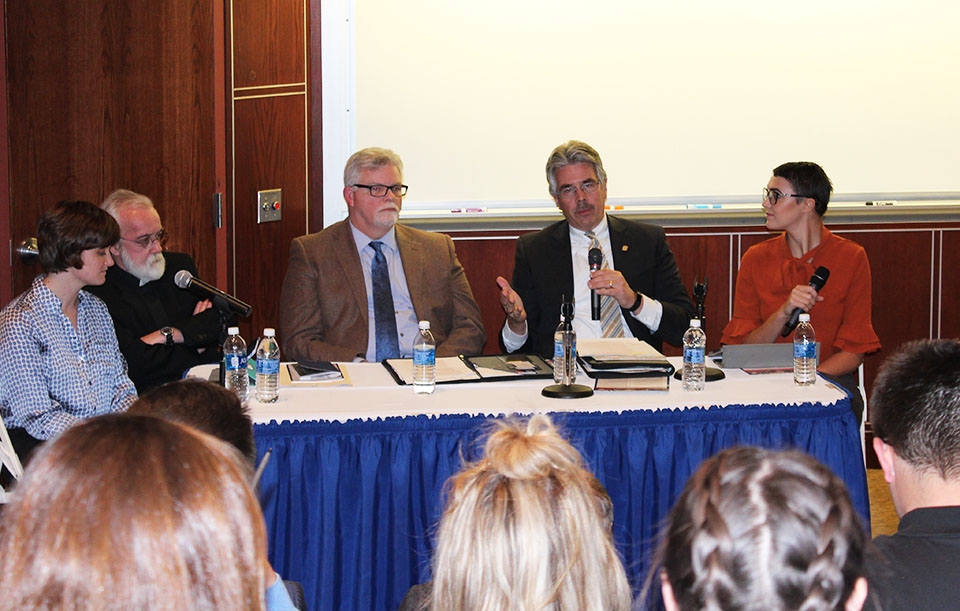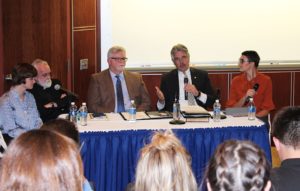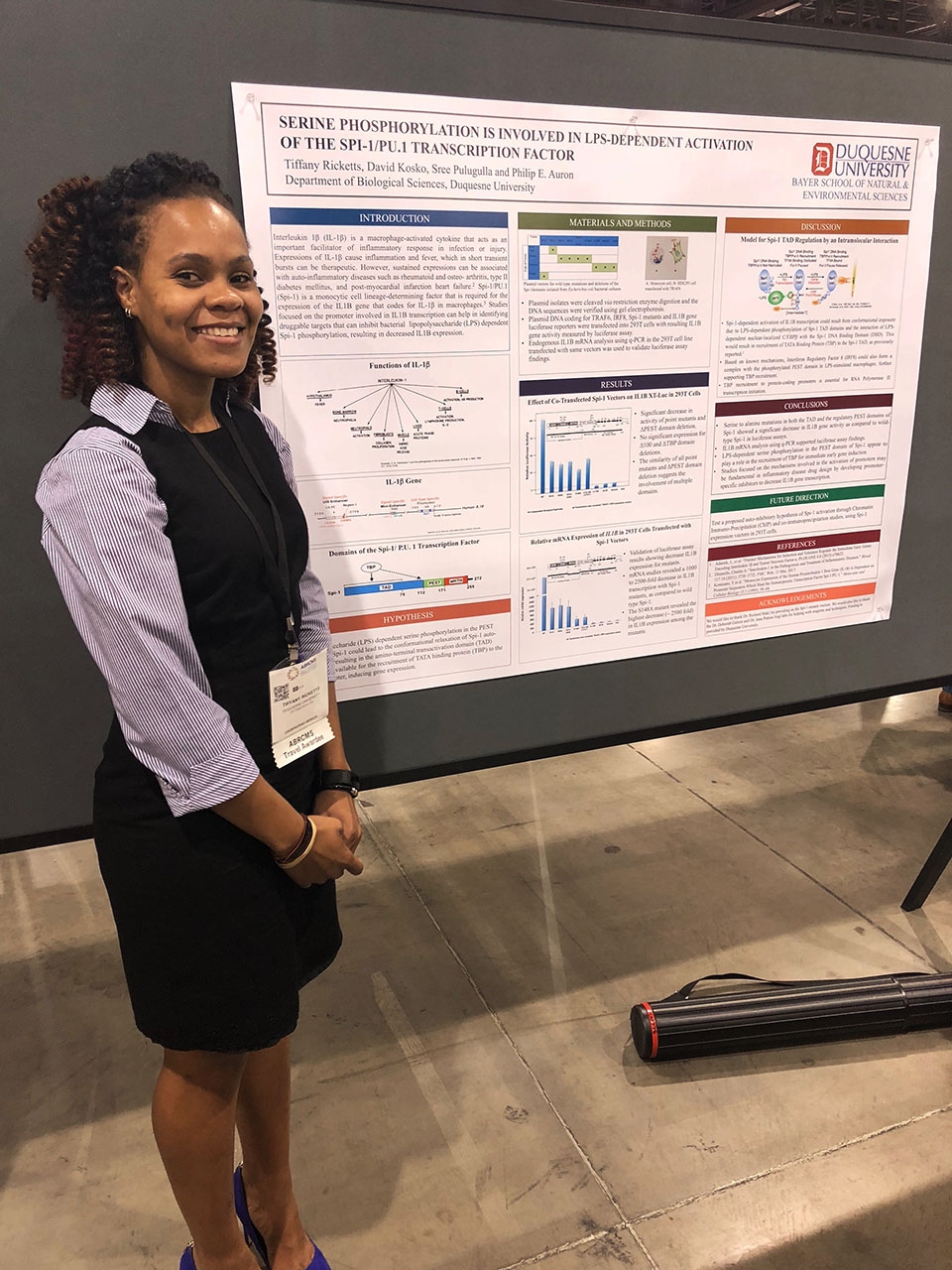
President Gormley answers student questions during the Nov. 13 “Fireside Chat” panel.

President Gormley answers student questions during the Nov. 13 “Fireside Chat” panel.
Raymond Arke | News Editor
11/16/17
On Nov. 13, the student body had an opportunity to engage with Duquesne’s administration about the university’s new five-year plan. The “Fireside Chat” with President Ken Gormley and other administration officials from Gormley’s advisory council was hosted by the Student Government Association.
The evening began with Gormley introducing and giving a quick overview of the plan which was designed to be “a guiding document” that will help administration members make decisions. The finished product was the culmination of over three years of work and involved five different task forces, some of which included students.
“Student leaders were very much involved,” in the creation process, Gormley said.
He believes it will help Duquesne prepare to tackle challenges facing the modern student.
“Student loans are a reality that place new burdens on students … [students] face even more daunting employment challenges,” he said. The goal is to “redefine what it means to be student-centered.”
Gormley said that the plan was designed with the student body in mind.
“[We] treat the best interest of our students as the pole star of every decision we make,” he said.
The first main pillar of the plan focuses on job preparedness in today’s competitive market. This includes the current redesign, rename and move of the Career Services Center into the sixth floor of the Student Union, where it will be called The Center for Career Development. It will replace the faculty dining hall.
Gormley also said this includes “reinvent[ing] our modern education … [to] deal with the deficits created by the tech you’re carrying around,” and including a focus on the importance of civil discourse.
The second pillar involves making Duquesne the “region’s flagship institution for community engagement,” according to the plan.
This, according to Gormley, means a focus on being involved in the local areas that have fallen on hard times, such as the Hill District and the Monongahela Valley.
“There is change coming and we want to be drivers of that change,” he said.
The third point on the plan focuses on creating more comprehensive and boundary-breaking academic experiences. Gormley discussed the creation of a simulation hospital which would bring students from a variety of health, science, business and liberal arts majors working together.
“Rigid academic silos … do not work any more,” he said.
Creating a more engaged and “vibrant” campus was the fourth strategic imperative. Gormley said that the plan laid out steps to create a diversity council and a staff advisory council, the latter of which was recently launched.
The fifth and final point on the plan was introducing an entrepreneurial spirit with a focus on encouraging investment in the university.
The next speaker was Douglas Frizzell, the vice president of student life for the university. He said that the plan would create new opportunities for students through projects like a career readiness council and enhancing the Center for Student Wellbeing. Frizzell also mentioned some bigger changes such as a move toward a “comprehensive sophomore year experience,” along with updating the curriculum and the possible “reimagin[ing] of the Student Union space.”
The remaining time was a question-and-answer session moderated by SGA President Olivia Erickson and former Duke Editor-in-Chief Kaye Burnet. The first question regarded how student input into the plan was considered.
Gormley said that students were able to contribute ideas through a variety of ways, including during the earliest steps of planning through the Provost’s office.
Frizzell said that he went out and talked to students in various working groups.
“Many of the things I spoke about today were really from the students,” he said.
Only two students, James Daher, the undergraduate student representative and Courtney Armstrong, the graduate student representative, served on the actual drafting panel.
Another question asked by the audience involved what changes were coming to Career Services. Gormley said the strategic plan was to make make “a more robust program … on steriods.” This would involve reaching out to various alumni in 35 cities that have expressed the desire to network with and help students, as well as making sure that those connections happen.
A student asked whether Duquesne is planning to compete with Carnegie Mellon University and the University of Pittsburgh in terms of technology education. Going against them head-on will “never happen,” said Gormley.
“But there are opportunities for us to be standing alongside them and partnering with them,” he said.
Gormley also said that in terms of future technology, Duquesne brings a special niche in ethics and in examining the impacts of tech. Duquesne’s national renown for ethics can be used to discuss the impact of driverless cars on jobs, for example.
Fr. Ray French, a Spiritan priest and vice president for mission and identity, fielded a question on including and recognizing those at Duquesne who are of a non-Catholic or non-belief system. He said that it is important to “change the thinking here” to focus on the students and “transcend whatever faith traditions” one might have.
“[The students] are our inspiration, not the other way around,” French said.
The panel was also asked about increasing diversity on Duquesne’s campus, both in the student body and in the faculty. According to College Board, Duquesne’s student population is 80 percent white.
James Swindal, dean of the Liberal Arts school, said that to boost diversity, he is considering looking into summer workshops to work with Pittsburgh Public School students. He also said that he plans to reach out to diverse graduate school students to groom toward becoming faculty members.
Gormley also reiterated that the plan called for the creation of a Diversity and Inclusion Council, which “will allow direct input to [Gormley’s] Cabinet.”
A student also asked how the administration plans to balance athletics and student priorities. Gormley said this is a common problem for a college president.
“Every president in every college … has to sort through [this],” he said. “Athletics is supposed to be part of what brings us together as a campus community, without getting crazy with supporting athletics.”
For example, the upcoming renovations for the Palumbo Center will be funded “100 percent” from outside sources, Gormley promised.
Dave Harper, Duquesne’s director of athletics, said that his goal is to “make Duquesne a national brand,” which would help all aspects of the university.
At the conclusion, Erickson felt the event was a success. “I think it went really well,” Erickson said. “We had a good student turnout.”
Between 25 and 30 students attended.
Gormley expressed a similar thought, calling it “a fabulous event.”
Kailey Love and Zach Landau contributed to this article.



